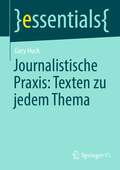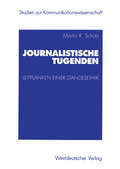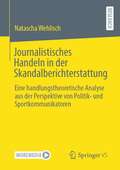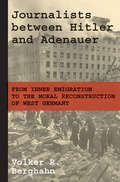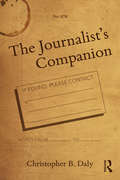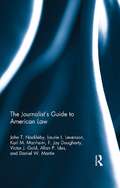- Table View
- List View
Journalistische Praxis: Texten zu jedem Thema (essentials)
by Gary HuckDieses Buch ist ein auf das Wesentliche reduziertes Einstiegswerk für professionelles Schreiben. Sie erhalten Grundwissen darüber, wie Sie ein Thema für Ihren Text finden, wie Sie dieses Thema in einer Recherche vertiefen und anschließend die Recherche als Text umsetzen. Neben theoretischem Wissen enthält dieses Buch auch Beispiele aus der Praxis, die die theoretischen Inhalte veranschaulichen. Dieses Buch soll vor allem Einsteigern im Bereich Texten helfen, schnell grundlegende Fähigkeiten aufzubauen, um aussagekräftige Texte zu verfassen. Es war die Intention des Buches, einen Leitfaden für Volontäre und Trainees aus den Bereichen Medien und Kommunikation zu schaffen, durch den man innerhalb eines Nachmittags die Grundlagen des Textens lernen kann. Auch soll dieses Buch seine Leser dazu anregen, ihr Wissen konsequent praktisch anzuwenden und sich weiter mit der Materie Texten auseinanderzusetzen.
Journalistische Tugenden: Leitplanken einer Standesethik (Studien zur Kommunikationswissenschaft)
by Martin SchützEin werteorientierter Journalismus schafft die besten Voraussetzungen für einen guten Journalismus. In einer freiheitlichen Gesellschaft sehen sich Journalistinnen und Journalisten allerdings den unterschiedlichsten Ansprüchen gegenüber: Verlegerkalkül und öffentlicher Auftrag prallen oft aufeinander. Die Arbeit fragt daher auch nach den Rollenanforderungen, denen Medienschaffende in liberalen Demokratien gerecht werden müssen. Sie verbindet praktisch erfahrene Probleme mit philosophischer Reflexion.
Journalistisches Handeln in der Skandalberichterstattung: Eine handlungstheoretische Analyse aus der Perspektive von Politik- und Sportkommunikatoren
by Natascha WehlischSkandale sind zweifellos ein wichtiges Korrektiv innerhalb demokratischer Gesellschaften. Gleichzeitig kritisieren Sozialwissenschaftler den verstärkten Einsatz von Skandalisierungen als Mittel im massenmedialen Aufmerksamkeitswettbewerb sowie beobachtbare Personalisierungs- und Boulevardisierungstendenzen der Berichterstattung, die langfristig zu dysfunktionalen Effekten in der Bevölkerung wie einem Überdruss an Skandalen, Abstumpfungseffekten und gesellschaftlicher Instabilität führen können. Die Autorin zeigt aufbauend auf einem strukturell-individualistischen Modell sowie leitfadengestützten Experteninterviews mit Journalisten verschiedener Mediengattungen und Ressorts, wie unterschiedliche interne und externe Bedingungen die Handlungsentscheidung von Journalisten in Skandalsituationen beeinflussen und wie Einzelhandlungen verschiedener Akteure in ihrer Aggregation zu unerwünschten gesellschaftlichen Folgeeffekten führen können. Die Ergebnisse der Arbeit sollen zu einer Versachlichung der Diskussion beitragen und negativen Folgeeffekten zunehmender medialer Skandalisierung durch eine Sensibilisierung der Akteure entgegenwirken.
Journalists between Hitler and Adenauer: From Inner Emigration to the Moral Reconstruction of West Germany
by Volker R. BerghahnThe moral and political role of German journalists before, during, and after the Nazi dictatorshipJournalists between Hitler and Adenauer takes an in-depth look at German journalism from the late Weimar period through the postwar decades. Illuminating the roles played by journalists in the media metropolis of Hamburg, Volker Berghahn focuses on the lives and work of three remarkable individuals: Marion Countess Dönhoff, distinguished editor of Die Zeit; Paul Sethe, “the grand old man of West German journalism”; and Hans Zehrer, editor in chief of Die Welt.All born before 1914, Dönhoff, Sethe, and Zehrer witnessed the Weimar Republic’s end and opposed Hitler. When the latter seized power in 1933, they were, like their fellow Germans, confronted with the difficult choice of entering exile, becoming part of the active resistance, or joining the Nazi Party. Instead, they followed a fourth path—“inner emigration”—psychologically distancing themselves from the regime, their writing falling into a gray zone between grudging collaboration and active resistance. During the war, Dönhoff and Sethe had links to the 1944 conspiracy to kill Hitler, while Zehrer remained out of sight on a North Sea island. In the decades after 1945, all three became major figures in the West German media. Berghahn considers how these journalists and those who chose inner emigration interpreted Germany’s horrific past and how they helped to morally and politically shape the reconstruction of the country.With fresh archival materials, Journalists between Hitler and Adenauer sheds essential light on the influential position of the German media in the mid-twentieth century and raises questions about modern journalism that remain topical today.
Journalists between Hitler and Adenauer: From Inner Emigration to the Moral Reconstruction of West Germany
by Volker R. BerghahnThe moral and political role of German journalists before, during, and after the Nazi dictatorshipJournalists between Hitler and Adenauer takes an in-depth look at German journalism from the late Weimar period through the postwar decades. Illuminating the roles played by journalists in the media metropolis of Hamburg, Volker Berghahn focuses on the lives and work of three remarkable individuals: Marion Countess Dönhoff, distinguished editor of Die Zeit; Paul Sethe, “the grand old man of West German journalism”; and Hans Zehrer, editor in chief of Die Welt.All born before 1914, Dönhoff, Sethe, and Zehrer witnessed the Weimar Republic’s end and opposed Hitler. When the latter seized power in 1933, they were, like their fellow Germans, confronted with the difficult choice of entering exile, becoming part of the active resistance, or joining the Nazi Party. Instead, they followed a fourth path—“inner emigration”—psychologically distancing themselves from the regime, their writing falling into a gray zone between grudging collaboration and active resistance. During the war, Dönhoff and Sethe had links to the 1944 conspiracy to kill Hitler, while Zehrer remained out of sight on a North Sea island. In the decades after 1945, all three became major figures in the West German media. Berghahn considers how these journalists and those who chose inner emigration interpreted Germany’s horrific past and how they helped to morally and politically shape the reconstruction of the country.With fresh archival materials, Journalists between Hitler and Adenauer sheds essential light on the influential position of the German media in the mid-twentieth century and raises questions about modern journalism that remain topical today.
The Journalist's Companion
by Christopher B. DalyThe Journalist’s Companion is the book for every journalist and journalism student’s coat pocket or backpack. Anchored by an annotated copy of the U.S. Constitution, this slim and portable volume provides guidance, inspiration, and practical advice for being a journalist today. A veteran front-line news reporter and professor of journalism for another twenty years, Christopher B. Daly has seen the attempts to silence and intimidate journalists. The Journalist’s Companion gives reporters, editors, and students the inspiration to stand tall along with advice to do their work well, accurately, and fearlessly. This book also includes a brief guide on how to file a Freedom of Information Act demand, a checklist for reporters and editors designed to increase the level of accuracy in their work, a primer on copyright and professional courtesy, and a quick guide to staying safe while on assignment.
The Journalist's Companion
by Christopher B. DalyThe Journalist’s Companion is the book for every journalist and journalism student’s coat pocket or backpack. Anchored by an annotated copy of the U.S. Constitution, this slim and portable volume provides guidance, inspiration, and practical advice for being a journalist today. A veteran front-line news reporter and professor of journalism for another twenty years, Christopher B. Daly has seen the attempts to silence and intimidate journalists. The Journalist’s Companion gives reporters, editors, and students the inspiration to stand tall along with advice to do their work well, accurately, and fearlessly. This book also includes a brief guide on how to file a Freedom of Information Act demand, a checklist for reporters and editors designed to increase the level of accuracy in their work, a primer on copyright and professional courtesy, and a quick guide to staying safe while on assignment.
The Journalist's Guide to American Law
by John T. NocklebyThis easy-to-use guidebook offers an overview of American law that should find a place on the desk of any journalism student or professional journalist. The Journalist’s Guide to American Law provides an overview of major legal principles and issues in practical terms for journalists covering any aspect of the legal system. The book’s organization captures both the bird’s-eye view of the subject and offers an easy reference guide when the professional needs to understand a distinct legal concept. The areas covered range from professional concerns such as the First Amendment, cameras in the courtroom, Sunshine laws, and access to government documents to general legal matters such as the institutions of law and the lawmaking function of the judiciary, core constitutional principles such as separation of powers and judicial review, and the day-to-day functioning of courts. Equally at home on the desk of the general assignment reporter or the legal correspondent, as well as their producers and editors, the book equips the journalist with the knowledge required to translate complex legal notions into plain English.
The Journalist's Guide to American Law
by John T. Nockleby Laurie L. Levenson Karl M. Manheim F. Jay Dougherty Victor J. Gold Allan Ides Daniel W. MartinThis easy-to-use guidebook offers an overview of American law that should find a place on the desk of any journalism student or professional journalist. The Journalist’s Guide to American Law provides an overview of major legal principles and issues in practical terms for journalists covering any aspect of the legal system. The book’s organization captures both the bird’s-eye view of the subject and offers an easy reference guide when the professional needs to understand a distinct legal concept. The areas covered range from professional concerns such as the First Amendment, cameras in the courtroom, Sunshine laws, and access to government documents to general legal matters such as the institutions of law and the lawmaking function of the judiciary, core constitutional principles such as separation of powers and judicial review, and the day-to-day functioning of courts. Equally at home on the desk of the general assignment reporter or the legal correspondent, as well as their producers and editors, the book equips the journalist with the knowledge required to translate complex legal notions into plain English.
The Journalist's Guide to Media Law: A handbook for communicators in a digital world
by Mark Polden Mark PearsonWe are all journalists and publishers now: at the touch of a button we can send our words, sounds and images out to the world. No matter whether you're a traditional journalist, a blogger, a public relations practitioner or a social media editor, everything you publish or broadcast is subject to the law. But which law?This widely used practical guide to communication law is essential reading for anyone who writes or broadcasts professionally, whether in journalism or strategic communication. It offers a mindful approach to assessing media law risks so practitioners can navigate legal and ethical barriers to publishing in mainstream and social media.This sixth edition has been substantially revised to reflect recent developments in litigation, and the impact of national security laws and the rising gig economy where graduates might work in the news media, PR, new media start-ups, or as freelancers. It covers defamation, contempt, confidentiality, privacy, trespass, intellectual property, and ethical regulation, as well as the special challenges of commenting on criminal allegations and trials. Recent cases and examples from social media, journalism and public relations are used to illustrate key points and new developments. Whether you work in a news room, in public relations or marketing, or blog from home, make sure you have The Journalist's Guide to Media Law at your side.'Whether you're an MSM editor or reporter, a blogger, a tweeter or a personal brand, this book might save your bacon.' - Jonathan Holmes, former ABC Media Watch host'The leading text book from which most journos learned their law' - Margaret Simons, associate professor in journalism, Monash University
The Journalist's Guide to Media Law: A handbook for communicators in a digital world
by Mark Polden Mark PearsonWe are all journalists and publishers now: at the touch of a button we can send our words, sounds and images out to the world. No matter whether you're a traditional journalist, a blogger, a public relations practitioner or a social media editor, everything you publish or broadcast is subject to the law. But which law?This widely used practical guide to communication law is essential reading for anyone who writes or broadcasts professionally, whether in journalism or strategic communication. It offers a mindful approach to assessing media law risks so practitioners can navigate legal and ethical barriers to publishing in mainstream and social media.This sixth edition has been substantially revised to reflect recent developments in litigation, and the impact of national security laws and the rising gig economy where graduates might work in the news media, PR, new media start-ups, or as freelancers. It covers defamation, contempt, confidentiality, privacy, trespass, intellectual property, and ethical regulation, as well as the special challenges of commenting on criminal allegations and trials. Recent cases and examples from social media, journalism and public relations are used to illustrate key points and new developments. Whether you work in a news room, in public relations or marketing, or blog from home, make sure you have The Journalist's Guide to Media Law at your side.'Whether you're an MSM editor or reporter, a blogger, a tweeter or a personal brand, this book might save your bacon.' - Jonathan Holmes, former ABC Media Watch host'The leading text book from which most journos learned their law' - Margaret Simons, associate professor in journalism, Monash University
The Journalist's Handbook
by Kim FletcherThis comprehensive, informative and witty guide offers expert advice on everything you need to know about the industry. From starting up, through pitching your first story, to getting a scoop and avoiding libel, this book offers all the useful hints, advice and contacts you require to be the best. The Journalist's Handbook contains vital information on media law, privacy and ethics, and looks at market awareness and the rise of internet journalism. There is also good advice on different writing techniques for quality, middle market and popular papers, on surviving as a freelance and advancing in your career. Interspersed with anecdotes and tips from journalists on Britain's leading publications (Observer, Express, Star, The Times, Q, Glamour), the handbook is rounded off with a list of indispensable contacts and sources.
Journalists in Peril
by Nancy J. Woodhull Robert W. SnyderThreats to journalists carry many different lessons, but one is constant: People who would intimidate or kill journalists are usually terrified that someone might find out. Journalists who want to protect one another need do nothing more than what should come naturally to them: report on threats to journalists--big threats and small threats, whether they are directed against the international luminaries of the profession or small timers. Non-journalists can also play a big part in the fight to protect journalists. Next to tough and timely reporting that establishes the facts of a case, nothing protects a journalist so much as public outrage and public support. Ordinary citizens can play an enormous role by pressuring thugs and tyrants who would like to stifle the freedom of the press. The freedom of journalists is consequently the bedrock of freedom for all people. Chapters and contributors to 'Journalists in Peril' include: "The Clash of Arms in Exotic Locales" by Peter Arnett; "Press Freedom--Balkan Style" by Kati Marton; "Grim Prospects for Hong Kong" by John Schidlovsky; "Russian Reporters--Between a Hammer and an Anvil" by losif M. Dzyaloshinsky; "Defiant Publishing in Nigeria" by Dapo Olorunyomi; "Turkish Journalists on Trial" by Ahmet Emin; "In America, Justice for Some" by Ana Arana; and "Blood and Fear in Italy" by Candida Curzi. The tragic accounts detailed in 'Journalists in Peril' are poignantly written and are important reading for all concerned with democracy in the world, especially political scientists, government officials, and those involved in the various communications professions.
Journalists in Peril
by Nancy J. Woodhull Robert W. SnyderThreats to journalists carry many different lessons, but one is constant: People who would intimidate or kill journalists are usually terrified that someone might find out. Journalists who want to protect one another need do nothing more than what should come naturally to them: report on threats to journalists--big threats and small threats, whether they are directed against the international luminaries of the profession or small timers. Non-journalists can also play a big part in the fight to protect journalists. Next to tough and timely reporting that establishes the facts of a case, nothing protects a journalist so much as public outrage and public support. Ordinary citizens can play an enormous role by pressuring thugs and tyrants who would like to stifle the freedom of the press. The freedom of journalists is consequently the bedrock of freedom for all people. Chapters and contributors to 'Journalists in Peril' include: "The Clash of Arms in Exotic Locales" by Peter Arnett; "Press Freedom--Balkan Style" by Kati Marton; "Grim Prospects for Hong Kong" by John Schidlovsky; "Russian Reporters--Between a Hammer and an Anvil" by losif M. Dzyaloshinsky; "Defiant Publishing in Nigeria" by Dapo Olorunyomi; "Turkish Journalists on Trial" by Ahmet Emin; "In America, Justice for Some" by Ana Arana; and "Blood and Fear in Italy" by Candida Curzi. The tragic accounts detailed in 'Journalists in Peril' are poignantly written and are important reading for all concerned with democracy in the world, especially political scientists, government officials, and those involved in the various communications professions.
The Journalist’s Toolbox: A Guide to Digital Reporting and AI
by Mike ReilleyFocusing on the "how" and "why" of digital reporting, this interactive textbook equips readers with all the skills they need to succeed in today’s multimedia reporting landscape. The Journalist’s Toolbox is an extension of the JournalistsToolbox.ai website, which provides links to tools, organized by beats and topics, as well as social channels, a newsletter, and more than 95 training videos relevant to journalists. This handbook offers a deep dive into these digital resources, explaining how they can be manipulated to build multimedia stories online and in broadcast. It covers all the basics of data journalism, fact-checking, using social media, editing and ethics, as well as video, photo, and audio production and storytelling. The book considers digital journalism from a global perspective, including examples and interviews with journalists from around the world. Packed full of hands-on exercises and insider tips, The Journalist’s Toolbox is an essential companion for students of online/digital journalism, multimedia storytelling and advanced reporting. This book will also make an ideal reference for practicing journalists looking to hone their craft. This book is supported by training videos, interactive charts and a pop-up glossary of key terms which are available as part of an interactive e-book+ or online for those using the print book.
The Journalist’s Toolbox: A Guide to Digital Reporting and AI
by Mike ReilleyFocusing on the "how" and "why" of digital reporting, this interactive textbook equips readers with all the skills they need to succeed in today’s multimedia reporting landscape. The Journalist’s Toolbox is an extension of the JournalistsToolbox.ai website, which provides links to tools, organized by beats and topics, as well as social channels, a newsletter, and more than 95 training videos relevant to journalists. This handbook offers a deep dive into these digital resources, explaining how they can be manipulated to build multimedia stories online and in broadcast. It covers all the basics of data journalism, fact-checking, using social media, editing and ethics, as well as video, photo, and audio production and storytelling. The book considers digital journalism from a global perspective, including examples and interviews with journalists from around the world. Packed full of hands-on exercises and insider tips, The Journalist’s Toolbox is an essential companion for students of online/digital journalism, multimedia storytelling and advanced reporting. This book will also make an ideal reference for practicing journalists looking to hone their craft. This book is supported by training videos, interactive charts and a pop-up glossary of key terms which are available as part of an interactive e-book+ or online for those using the print book.
Journalists under Fire: The Psychological Hazards of Covering War
by Anthony FeinsteinAs journalists in Iraq and other hot spots around the world continue to face harrowing dangers and personal threats, neuropsychiatrist Anthony Feinstein offers a timely and important exploration into the psychological damage of those who, armed only with pen, tape recorder, or camera, bear witness to horror. Based on a series of recent studies investigating the emotional impact of war on the profession, Journalists under Fire breaks new ground in the study of trauma-related disorders. Feinstein opens with an overview of the life-threatening hazards war reporters face—abductions, mock executions, the deaths of close colleagues—and discusses their psychological consequences: post-traumatic stress disorder, depression, deterioration of personal relationships, and substance abuse. In recounting the experiences of reporters who encounter trauma on the job, Feinstein observes that few adequate support systems are in place for them. He tells the stories of media veterans who have "seen it all," only to find themselves and their employers blindsided by psychological aftershocks. The book explores the biological and psychological factors that motivate journalists to take extraordinary risks. Feinstein looks into the psyches of freelancers who wade into war zones with little or no financial backing; he examines the different stresses encountered by women working in a historically male-dominated profession; and he probes the effects of the September 11 attacks on reporters who thought they had sworn off conflict reporting. His interviews with many of this generation's greatest reporters, photographers, and videographers often reveal extraordinary resilience in the face of adversity. Journalists under Fire is a look behind the public persona of war journalists at a time when the profession faces unprecedented risk. Plucking common threads from disparate stories, Feinstein weaves a narrative that is as fascinating to read as it is sobering to contemplate. What emerges are unique insights into lives lived dangerously.
Journalists Under Fire: Information War and Journalistic Practices
by Howard Tumber Professor Frank Webster'...it will appeal not only to students of journalism and media but also to anyone interested in the world around them' - Marie Kinsey, Times Higher Education Supplement 'Professor Tumber weaves together traditional and topical themes to produce a comprehensive overview of the media's role at times of conflict' - Stewart Purvis, City University London 'Presents a vivid picture of what it’s like to be working as a journalist on the front line during a ‘modern’ war. Through the eyes of leading correspondents in the field the authors examine their experience and its impact on the audience, their profession and their own lives' - The Information Centre about Asylum and Refugees in the UK (ICAR) Journalists Under Fire is the first book to combine a conceptually audacious analysis of the changing nature of war with an empirically rich critical analysis of journalists who cover conflict. In Journalists Under Fire, authors Howard Tumber and Frank Webster explore questions about the information war and journalistic practices. Frontline correspondents play a key role in information war, but their position is considerably more ambiguous and ambivalent than in the epoch of industrial war. They play a central role in the presentation of what is often spectacle to audiences around the world whose actual experience of war is far removed from combat. In the era of multi-national journalism, of the internet and satellite videophone, the book highlights central features of media reporting in contemporary conflict. Drawing on over fifty lengthy interviews with frontline correspondents, the authors shed light on the motivations, fears and practices of those who work under conditions of journalism under fire. Journalists Under Fire is designed for undergraduate and postgraduate students and for scholars, academics and researchers in the fields of journalism, media and communication, Media Studies, sociology, international relations and war studies.
Journals 1982
by Anthony PowellDuring the eighties, while working on a novel which had become 'stuck', Anthony Powell, one of the greatest of twentieth-century Enlgish novelists, began writing a journal. Gossipy, delightful, sometimes barbed, these journals give a fascinating insight into the writer's life: the people he met, the places her visited and the parties he went to. The acute intelligence and wit which has made A Dance to the Music of Time one of the best loved novels in English is ever-present in these papers, where the reader will encounter Osbert Lancaster, Kingsley Amis, Philip Larkin, Lord Longford - all viewed with affection and a startling frankness.
Journals 1990-1992
by Anthony PowellThe first two volumes of Anthony Powell's journals have already been publilshed, to great critical acclaim. These journals started in 1982 when Powell had become 'stuck' on a novel, became the place where he could most happily exercise his powers of observation, and record his memories of times and writers past.This, the third volume of his journals, sees the writer in his house in Somerset, the Chantry, encountering old friends, journalists, publishers, relations. He rereads the plays of Shakespeare, and revisits the work of a huge range of writers, from Ivy Compton-Burnett to L. Rider Haggard. He remembers Evelyn Waugh, Philip Larkin, Malcolm Muggeridge, John Betjeman, Kingsley Amis and Marlene Dietrich. He is visted by, among other, V.S. Naipaul, Alison Lurie, Harold Pinter, Antonia Fraser and Evangeline Bruce. The author is given an honorary doctorate from the University of Wales, in the dining-room of Chantry. In these frank and entertaining pages, the daily life of a great literary figure unfolds in an volume that will delight his many fans as much as its predecessors did.
The Journals and Diaries of E M Forster Vol 1
by Philip GardnerA writer of fiction, literary criticism, travel narratives and libretti, E M Forster is best known for his beautifully-structured novels which held a mirror up to the English class system. This fascinating collection of diaries, travel journals and itineraries brings together all unpublished material Forster wrote which can be classed as ‘memoir’.
The Journals and Diaries of E M Forster Vol 1
by Philip GardnerA writer of fiction, literary criticism, travel narratives and libretti, E M Forster is best known for his beautifully-structured novels which held a mirror up to the English class system. This fascinating collection of diaries, travel journals and itineraries brings together all unpublished material Forster wrote which can be classed as ‘memoir’.
The Journals and Diaries of E M Forster Vol 2
by Philip GardnerA writer of fiction, literary criticism, travel narratives and libretti, E M Forster is best known for his beautifully-structured novels which held a mirror up to the English class system. This fascinating collection of diaries, travel journals and itineraries brings together all unpublished material Forster wrote which can be classed as ‘memoir’.
The Journals and Diaries of E M Forster Vol 2
by Philip GardnerA writer of fiction, literary criticism, travel narratives and libretti, E M Forster is best known for his beautifully-structured novels which held a mirror up to the English class system. This fascinating collection of diaries, travel journals and itineraries brings together all unpublished material Forster wrote which can be classed as ‘memoir’.
The Journals and Diaries of E M Forster Vol 3
by Philip GardnerA writer of fiction, literary criticism, travel narratives and libretti, E M Forster is best known for his beautifully-structured novels which held a mirror up to the English class system. This fascinating collection of diaries, travel journals and itineraries brings together all unpublished material Forster wrote which can be classed as ‘memoir’.
